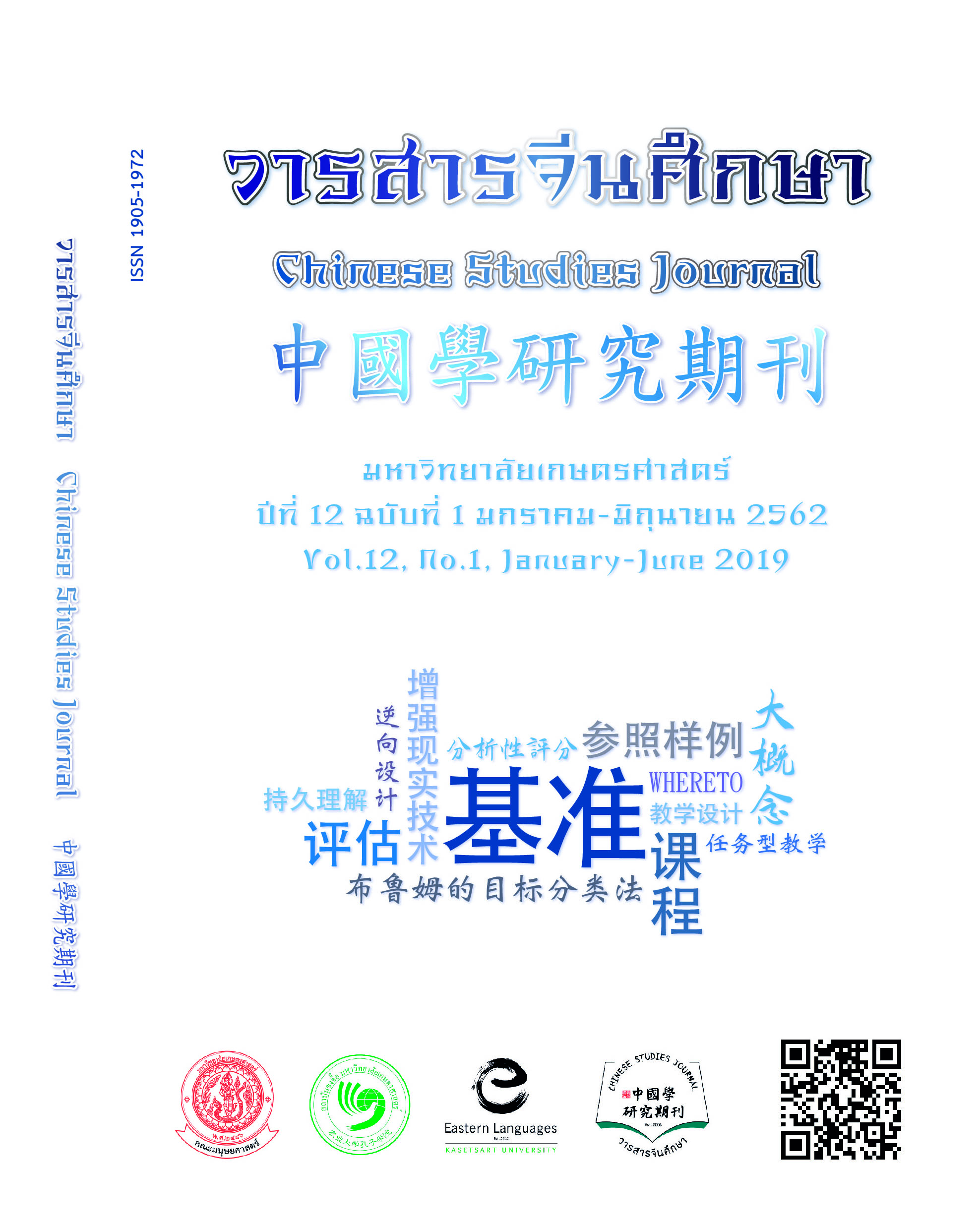A Comparative Analysis of Thai and Chinese “HEART” Metaphor Based on Conceptual Integration Theory
Main Article Content
Abstract
Conceptual Integration Theory, as a new theory in the field of cognitive linguistics, provides an enlightening way of thinking for human understanding of its cognitive mechanism from the perspective of mental space and conceptual integration. Such theory of conceptual blending is not only a basic dynamic cognitive construction process of human beings, but also an important cognitive way for human beings to understand the world and form innovative thinking, especially emphasize the viewpoint of the emergent meaning in the conceptual blending process. In conceptual integration, elements and vital relations from diverse scenarios are blended in a subconscious process, which is assumed to be ubiquitous in everyday thought and language. Metaphorical meanings of the word “heart” in the Thai and Chinese languages were analyzed by conceptual integration. Results were that similarities and differences existed. In both languages, “heart” was seen as the center of people’s being, thinking, emotion, personality and soul. “Heart” is at the center of the body, playing a vital role in the operation of life. Moreover, in Thai and Chinese, the word also underwent a metaphorical extension from bodily organ to spatial position and importance. Thai and Chinese people share commonalities in human physiological structure. They experience and understand the outside world through embodied cognition. Since people of different nationalities and cultures have different cognitive approaches, inconsistencies remain. Metaphorical concepts of “heart shape” and “middle part of the object” in Chinese was not found in Thai. In Thai, “heart” can allude to time. In this way, a conceptual integration network, a dynamic blended process through cross-space mapping of counterpart connection combined with background knowledge from multi-dimensional perspectives, is established.
Article Details
ผลงานทางวิชาการที่ลงตีพิมพ์ในวารสารจีนศึกษา มหาวิทยาลัยเกษตรศาสตร์ เป็นลิขสิทธิ์ของผู้เขียนหรือผู้แปลผลงานนั้น หากนำลงในวารสารจีนศึกษาเป็นครั้งแรก เจ้าของผลงานสามารถนำไปตีพิมพ์ซ้ำในวารสารหรือหนังสืออื่นได้โดยมิต้องแจ้งให้ทราบล่วงหน้า แต่หากผลงานที่ได้รับพิจารณานำลงในวารสารจีนศึกษา เป็นผลงานที่เคยตีพิมพ์ที่อื่นมาก่อนเจ้าของผลงานต้องจัดการเรื่องปัญหาลิขสิทธิ์กับแหล่งพิมพ์แรกเอง หากเกิดปัญหาทางกฎหมาย ถือว่าไม่อยู่ในความรับผิดชอบของวารสารจีนศึกษา มหาวิทยาลัยเกษตรศาสตร์ ทั้งนี้ ความคิดเห็นต่างๆ ในบทความเป็นความคิดเห็นส่วนตัวของผู้เขียน ไม่เกี่ยวกับกองบรรณาธิการวารสารจีนศึกษา มหาวิทยาลัยเกษตรศาสตร์
References
邓芷涓.(2013).中德“心”的词义对比研究.文学界:理论版,(1),137-138.
季风.(2013).北大国学课.新世界出版社.
李梓嫣.(2016).日语“心”义族词和汉语“心”的对应关系——兼论日本文化对情感的划分.语文学刊,(14),43-45.
齐振海.(2003).论“心”的隐喻——基于英,汉语料库的对比研究. 外语研究,(3),24-27.
肖锐.(2007).汉泰“心”族词对比研究(Master's thesis),云南师范大学.
曾祥星.(2006).基于语料库“心”的隐喻英汉对比研究 (Doctoral dissertation),华中科技大学.
赵燕华.(2015).汉越“心”的转喻义与隐喻义对比分析. 阜阳师范学院学报: 社会科学版,(1),53-56.
张瑞华.(2008).英汉“心”隐喻对比研究——与吴恩锋先生商榷. 北京第二外国语学院学报,(8),25-31.
张建理.(2006).英汉“心”的多义网络对比.浙江大学学報(人文社会科学版),36(3),161-168.
朱诗依,杨成虎.(2017).英汉语言中“心/heart”隐喻的一维性对比研究. 现代语文:下旬.语言研究,(10),135-138.
Coulson, S. (2001). Semantic leaps: Frame-shifting and conceptual blending in meaning construction. Cambridge University Press.
Fauconnier, Gilles. (1994). Mental spaces: Aspects of meaning construction in natural language. Cambridge University Press.
Fauconnier, Gilles. (1997). Mappings in thought and language. Cambridge University Press.
Fauconnier, G., & Turner, M. (1996). Blending as a central process of grammar. Conceptual structure, discourse, and language, 113, 130.
Fauconnier, G., & Turner, M. (1998). Conceptual integration networks. Cognitive science, 22(2), 133-187.
Lakoff, G., & Johnson, M. (1999). Philosophy in the Flesh— The Embodied Mind and Its Challenge to Western Thought. New york: Basic books.
Turner, M., & Fauconnier, G. (2002). The way we think. Conceptual Blending and the Mind’s Hidden Complexities, New York.
Sweetser, Eve. (1991). From etymology to pragmatics: Metaphorical and cultural aspects of semantic structure (Vol. 54). Cambridge University Press.
Yu, Ning. (2009). The Chinese HEART in a cognitive perspective: Culture, body, and language (Vol. 12). Walter de Gruyter.
จารุวรรณ ขำเพชร และคณะ. (2553). โครงการสายน้ำ: สายชีวิตและวัฒนธรรมคนริมน้ำ.
งานวิจันสนับสนุนโดยสำนักงานคณะกรรมการการอุดมศึกษา (สกอ.).
มนัส สุขสาย. (2526). หนังสืออ่านเสริมความรู้ เรื่องการบาศรีสูตรขวัญ. อุบลราชธานี: ศูนย์
การศึกษานอกโรงเรียน ภาคตะวันออกเฉียงเหนือ.
เบญจมาส แพทอง. (2540). บายศรี: สัญลักษณ์ของพิธีกรรมเกี่ยวกับชีวิต. กรุงเทพฯ:
กรมศิลปากร.
ปรีชา พิณทอง. (2549). ประเพณีโบราณไทยอีสาน. กรุงเทพฯ: ม.ป.พ.
ราชบัณฑิตยสถาน. (2556). พจนานุกรมฉบับราชบัณฑิตยสถาน พ.ศ. 2554. กรุงเทพฯ :
นานมีบุ๊คสพับลิเคชั่น.
ศิริพร สุวรรณศรี. (2536). ประเพณีการสู่ขวัญของชาวอําเภอเมืองร้อยเอ็ด จังหวัดร้อยเอ็ด.
ปริญญานิพนธ์ ศศ.ม. มหาสารคาม: บัณฑิตวิทยาลัยมหาวิทยาลัย มหาสารคาม.
สนิท สมัครการ. (2518). เรื่อง “หน้า” ของคนไทย วิเคราะห์ตามแนวคิดทางมานุษยวิทยา
ภาษาศาสตร์. พัฒนบริหารศาสตร์ (ตุลาคม 2518) : 492-505.
สุเมธ ชุมสาย ณ อยุธยา. (2529). น้ำ : บ่อเกิดแห่งวัฒนธรรมไทย. กรุงเทพฯ : ไทยวัฒนาพานิช.
อนัญญา คำเขียว. (2555). การศึกษาเพื่อการสร้างสรรค์:กรณีศึกษาประเพณีพิธีกรรมบายศรี
สู่ขวัญผู้ไทย อําเภอเรณูนคร จังหวัดนครพนม เพื่อการอนุรักษ์จารีตประเพณี. ปริญญานิพนธ์ ศป.ม. (ทัศนศลิป์:ศลิปะสมัยใหม).กรุงเทพฯ:บัณฑิตวิทยาลัยมหาวิทยาลัย
ศรีนครินทรวิโรฒ.


